 |
 |
 |
| |
Pooled 24-week results of DUET-1 and DUET-2: efficacy of TMC125 (etravirine; ETR) in treatment-experienced HIV-1-infected patients
|
| |
| |
Reported by Jules Levin
11TH EACS, Oct 24-27, 2007, Madrid
C Katlama,1 JM Gatell,2 JM Molina,3 M Peeters,4 J Vingerhoets,4 B Woodfall4
1Departement des Maladies Infectieuses et Tropicales, Paris, France; 2Infectious Diseases Unit, Hospital Clinic Barcelona, Barcelona, Spain;
3Department of Infectious Diseases, Saint-Louis Hospital and University of Paris, Paris, France; 4Tibotec BVBA, Mechelen, Belgium
AUTHOR CONCLUSIONS
In treatment-experienced patients, including those with NNRTI resistant virus, TMC125 consistently demonstrated superiority over placebo
-- 59% of patients achieved confirmed undetectable viral load <50 copies/mL (undetectable) with TMC125 plus BR at Week 24.
Even in the absence of any other fully active background agents, with TMC125, 45% of patients achieved <50 copies/mL viral load
-- response rates increased as more active agents were used in the BR.
Higher responses were apparent with TMC125 irrespective of baseline viral
load or CD4 cell count.
Thirteen TMC125 RAMs were identified
-- the greatest added benefit in the TMC125 versus placebo group was seen
in patients with <3 TMC125 RAMs
-- 86% of patients had <3 TMC125 RAMs.
TMC125 demonstrated significant activity and provides a new treatment option for patients with resistance to other NNRTIs.
Abstract
Objectives:TMC125 is a next-generation NNRTI with potent activity against HIV-1, including viruses with NNRTI resistance-associated mutations (RAMs). DUET-1 and DUET-2 are ongoing, randomised, placebo-controlled, double-blind, Phase III trials designed to show superiority of TMC125 plus background regimen (BR) over placebo plus BR in treatment-experienced HIV-1-infected patients. Trials differed only by geographical location. We report efficacy findings from planned, pooled analyses when patients reached Week 24 (or discontinued).
Methods: Patients with documented 1 or more NNRTI-RAMs at study entry and
3 or more primary protease inhibitor (PI) mutations were randomised to TMC125
200mg or placebo twice-daily with BR of darunavir/ritonavir (DRV/r), optimised NRTIs and optional enfuvirtide (ENF). The primary endpoint was proportion of patients with confirmed viral load <50 copies/mL at Week 24 (intent-to-treat population [ITT] time to loss of virological response imputation algorithm [TLOVR]). Primary analysis was according to ENF use (de novo versus re-using or not using).
Results: Baseline characteristics were generally similar across treatment arms. Overall, TMC125 was superior to placebo for efficacy endpoints (viral load <50 copies/mL: 59% vs 41%). TMC125 demonstrated a high barrier to resistance, with 3 or more TMC125-RAMs (selected NNRTI-RAMs) required to substantially reduce virological responses.
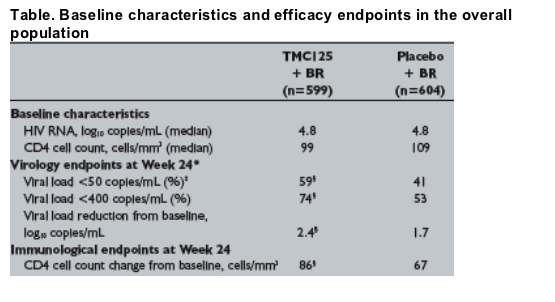
*Predictors of improved virological response were lower baseline viral load, greater number of active background antiretrovirals (ARVs), ENF use, lower TMC125 fold change (FC), fewer RAMs and lower DRV FC (p<0.0001). In patients receiving de-novo ENF, and accounting for DRV FC, significantly more patients responded with TMC125 than placebo (73% vs 62%; p<0.05). §p value vs placebo; p<0.0001
Conclusions: At 24 weeks, in patients with NNRTI-resistant virus, TMC125 plus BR provided superior virological and immunological response versus placebo plus BR.
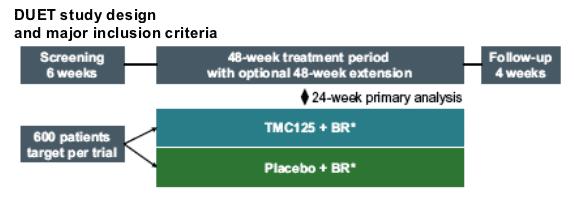
*All patients received a background regimen (BR)
of DRV/r with optimised NRTIs and optional ENF
DUET-1 and DUET-2 differed only in geographical location; pooled analysis was pre-specified
Major inclusion criteria
- plasma viral load >5,000 HIV-1 RNA copies/mL and stable therapy for 8 weeks
- 1 NNRTI mutation, at screening or in documented historical genotype
- 3 primary PI mutations at screening
Patients recruited from Thailand, Australia, Europe and the Americas
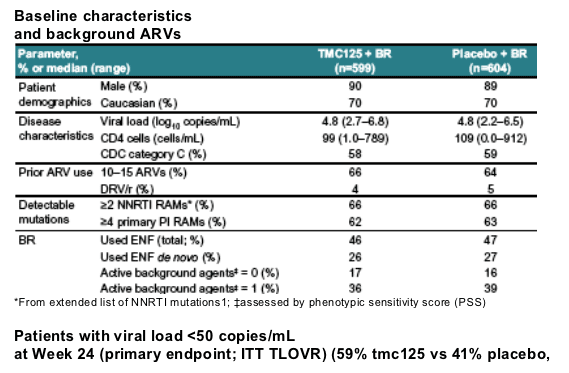
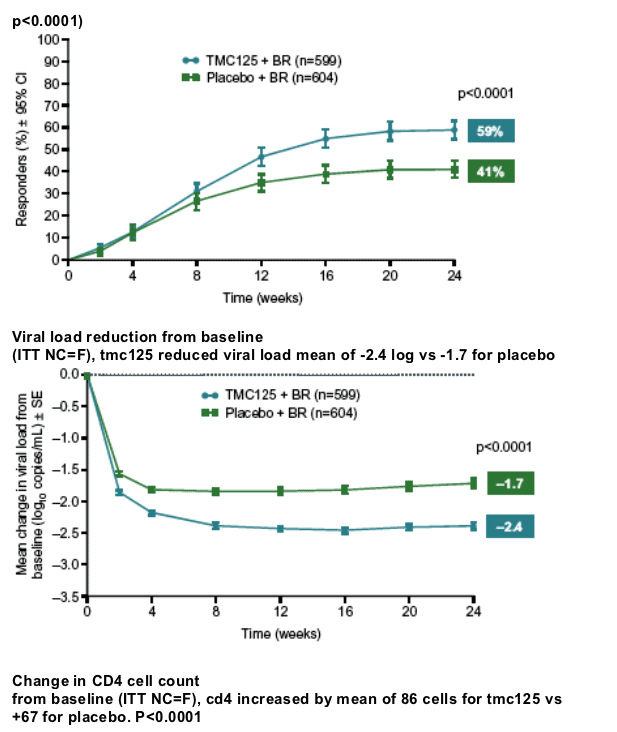
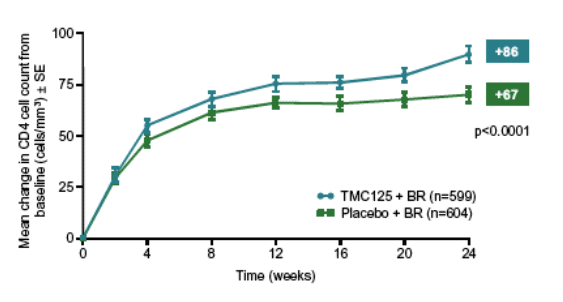
CD4 cell count increase to
50 cells/mm3 or above
At baseline, 36% and 35% of patients in the TMC125 and
placebo groups respectively had a CD4 cell count below 50 cells/mm3
(n=422 in total). At Week 24 in the TMC125 group 74% of these patients had moved above the 50 cells/mm3 threshold (n=157), compared with 55% in the
placebo group (n=115).
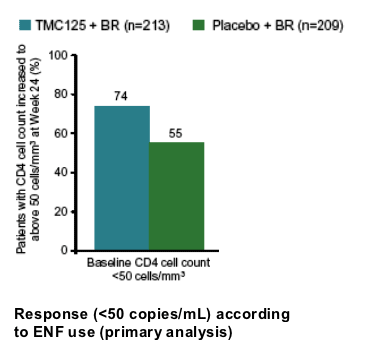
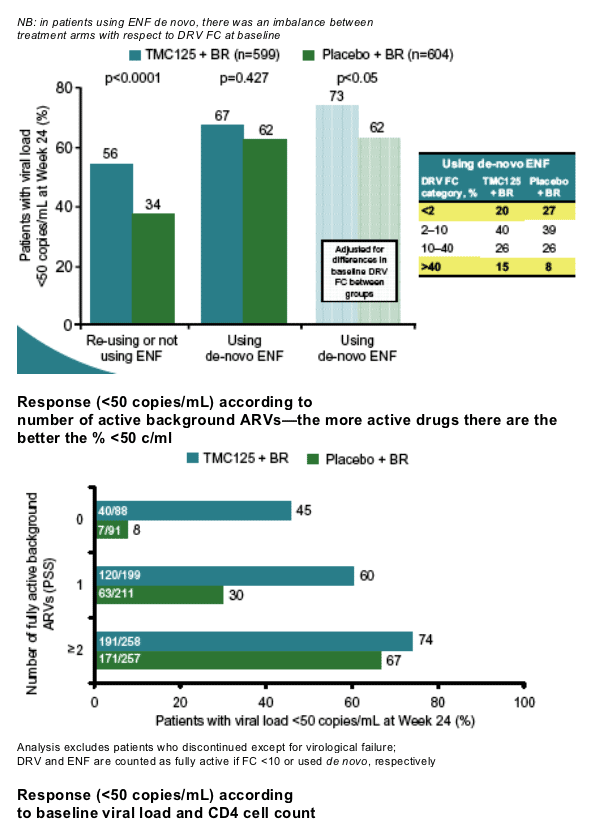
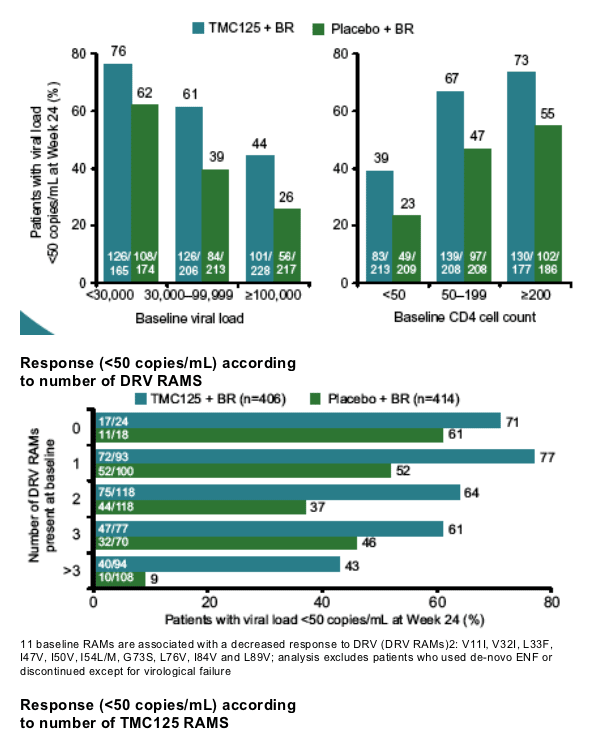
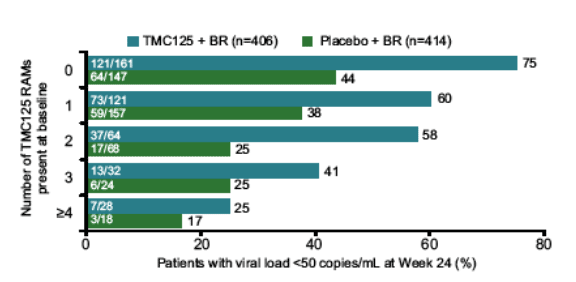
--The greatest added benefit in the TMC125 versus placebo group was seen in patients with <3 TMC125 RAMs
--86% of patients had <3 TMC125 RAMs
13 baseline RAMs were associated with a decreased response to TMC125 (TMC125 RAMs)3: V90I, A98G, L100I, K101E/P, V106I, V179D/F, Y181C/I/V, G190A/S. These RAMs occurred mainly in the presence of other NNRTI RAMs; analysis excludes patients who used de-novo ENF or discontinued except for virological failure
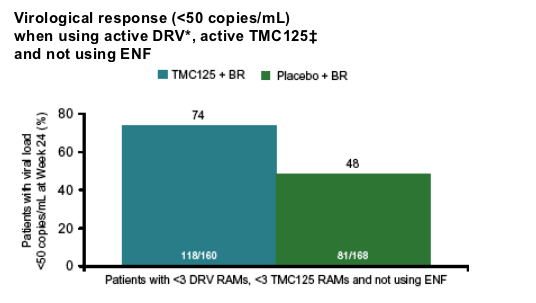
Excluding subjects who discontinued for non-virologic failure reasons; TLOVR imputation algorithm;
*defined as <3 DRV RAMs; defined as <3 TMC125 RAMs
References
1. Tambuyzer L, et al. EHDRW 2007. Abstract 67.
2. de Bethune MP, et al. EHDRW 2006. Abstract 51.
3. Vingerhoets J, et al. IHDRW 2007. Abstract 32.
|
| |
|
 |
 |
|
|